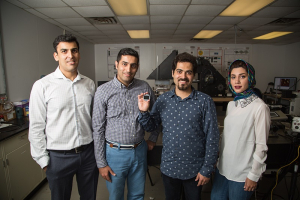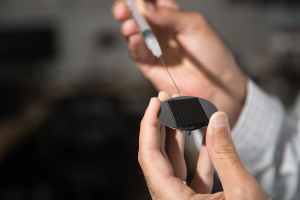In 1989, an Air Ontario flight, with ice and snow covering its wings during takeoff, fails to attain the proper altitude. Unable to get above the trees, it crashes into them, killing 25 passengers. In 1994, an American Eagle plane flies into treacherous icing conditions and the pilots lose control of the plane. It crashes, killing all 68 souls onboard. From 1990 to 2000, 12 percent of all weather-related air disasters were due to icing. It’s no surprise that the Air Safety Foundation states it clearly: “Ice in flight is bad news.”
Enter Hadi Ghasemi, Bill D. Cook Assistant Professor of mechanical engineering at the UH Cullen College. Read the latest issue of the journal Nature Communications and you will discover what Ghasemi has just invented in his lab: a new magnetic slippery surface (MAGSS) that outperforms all other icephobic surfaces in use. Icephobicity is one of those words that make pretty good sense: It means the ability of a surface to repel - or become almost phobic about - ice.
“These new surfaces provide the path to tackle the challenge of icing in systems, thereby improving the quality of human life,” said Ghasemi.
Icephobic surfaces play critical roles in industries ranging from transportation to power transmission. For scientists it’s been somewhat of a slippery subject – designing surfaces that are icephobic.
Widespread impact and improvement
In the aircraft industry, planes intercept super-cooled water droplets as they fly through clouds or encounter freezing rain. The droplets freeze rapidly on the surface, leading to ice accretion, or buildup. This ice accretion results in increased drag and may lead to loss of lift force and potentially catastrophic events.
In the power industry, icing in transmission systems can lead to collapse of poles and towers, rupture of conductors and flashover of insulators. At your house, a buildup of ice on your air conditioner can cause it to freeze, which will increase your bills or break the a/c unit completely.
The industrial and consumer applications are widespread for Ghasemi’s newly created MAGSS. He has a patent pending on it.
How it repels
Ghasemi’s material can be applied to any surface – ceramic, polymers or metals.
“We coat a magnetic material on one side of the surface and the other side we deposit a thin layer of magnetic fluid called ferrofluid,” said Ghasemi. The ferrofluid is a mixture of fluid and iron oxide nanoparticles.
The side with the ferrofluid faces outside. When a droplet of water hits the surface of the ferrofluid, this magnetic fluid acts as a barrier and doesn’t allow the droplet to interact with the solid.
“There’s no adhesion of the ice to the solid surface, so it basically slides off the surface,” said Ghasemi.
Why it’s better
Today’s icing systems seem frozen in time compared to Ghasemi’s. Case in point: The strength needed to remove ice. It’s measured in Pascals (Pa). Current systems use force measured at 100,000 Pa to remove ice. Ghasemi’s uses 2 Pascals. Two. Just two.
“This is so small that even by tilting the surface, ice is going to be removed,” said Ghasemi.
Ghasemi’s material also lowered the freezing threshold. With the best icephobic technology available today, water will freeze at minus 13 degrees Fahrenheit. If, however, a surface is coated with Ghasemi’s material, water would not freeze until it reached minus 29 degrees Fahrenheit.
What’s more, Ghasemi’s ferrofluids can regenerate themselves – or “self-heal,” as he calls it – and they are inexpensive.
Not out in the cold
Four of Ghasemi’s mechanical engineering students participate in the creation of the MAGGS and are listed as co-authors of the Nature Communications article. Peyman Irajizad and Nazanin Farokhnia are seeking Ph.D. degrees, Seyed Mohammad Sajadi is studying for his master’s and Munib Hasnain is an undergraduate.
Now that Ghasemi and his team have proved their concept, their next step is to get more money to create the new icephobic surfaces and move toward large-scale implementation of the material. The ultimate goal is to develop the coating as a spray that can be applied to any surface.
Ghasemi is a pretty cool character when it comes to explaining how he created this ice-repelling material that might well change the flight plan for so many industries.
“It just came to me,” he said.
That’s pretty chill.

